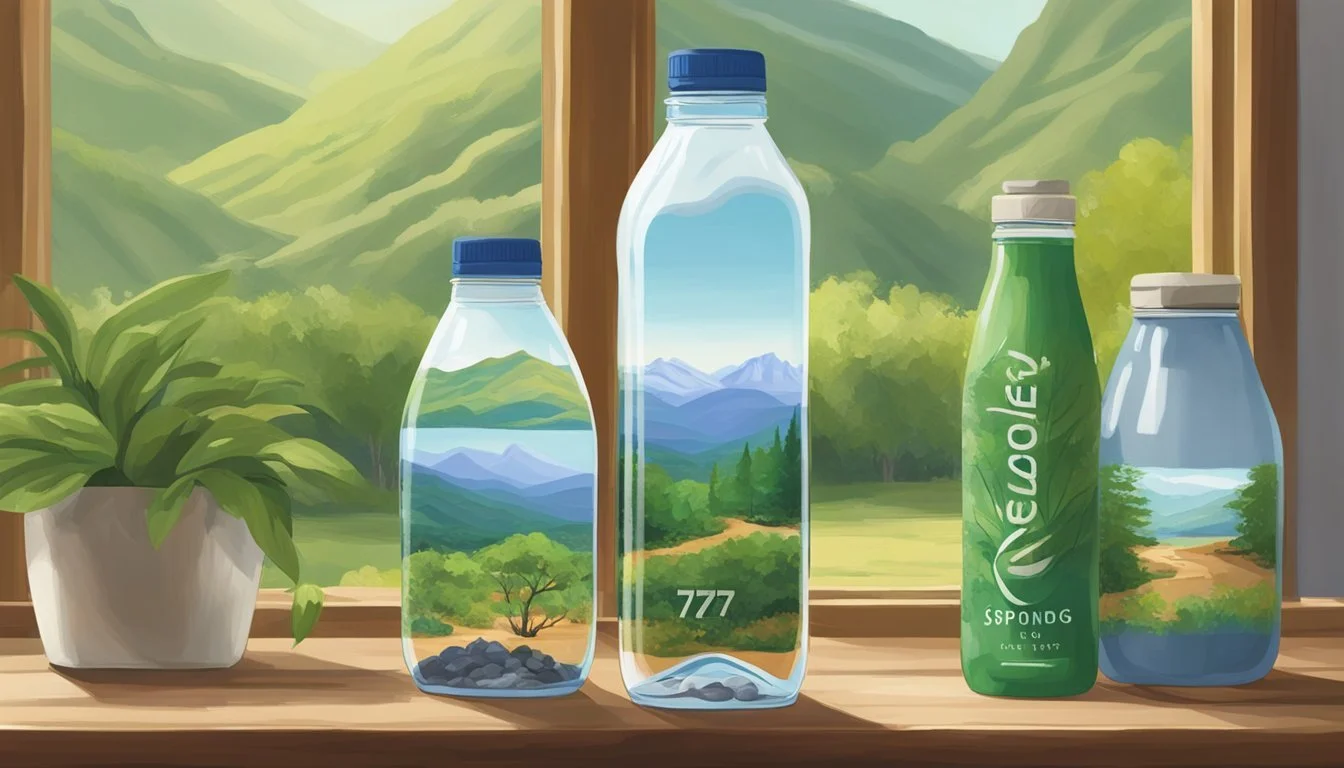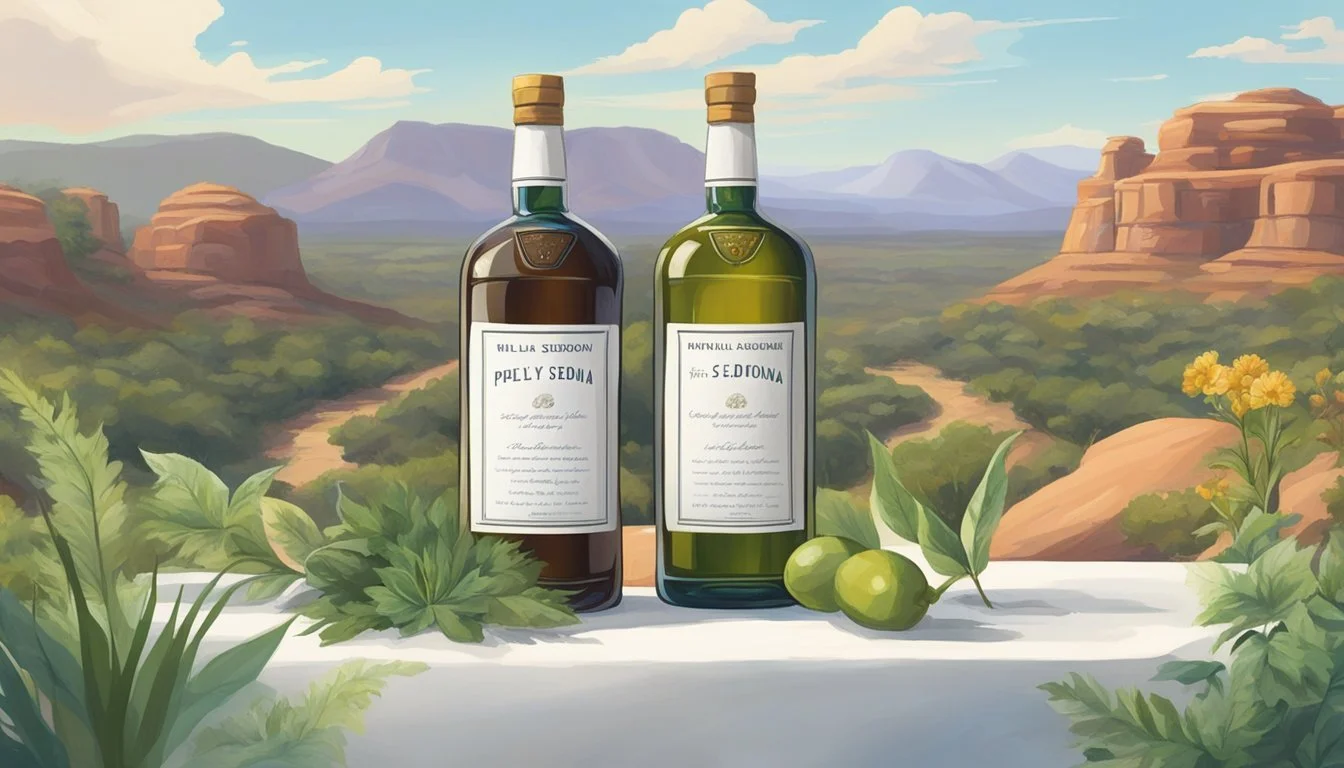Purely Sedona vs. Flow
Assessing the Best Bottled Water
Consumers often find themselves torn between premium bottled water brands such as Purely Sedona and Flow. Which bottled water is better? Purely Sedona boasts a balance of purity and affordability, making it accessible to a wide range of consumers. Its reputation is built on a commitment to excellent quality and local heritage, offering a refreshing choice without breaking the bank.
Flow, on the other hand, distinguishes itself with sustainable packaging and a focus on naturally alkaline water. Known for its eco-friendly approach, Flow appeals to environmentally conscious consumers. Those prioritizing sustainability might find Flow's unique packaging and natural mineral content to be major selling points.
Ultimately, the better choice depends on individual preferences and priorities. While Purely Sedona offers a reliable and cost-effective option, Flow's emphasis on sustainability and natural alkalinity caters to a niche market. This detailed comparison will help you decide which brand aligns with your needs.
Understanding Bottled Water
Bottled water comes in various types and undergoes meticulous processes to ensure safety and quality. Environmental considerations are also crucial when choosing bottled water.
Types of Bottled Water
Bottled water is available in several varieties, each with unique characteristics. Spring water is sourced from natural springs and often undergoes minimal processing. Mineral water contains minerals and trace elements naturally present at the source.
Purified water is treated water that may come from any source but is heavily processed to remove impurities through reverse osmosis, distillation, or other methods. Alkaline water has a higher pH level, often achieved by adding minerals. Finally, electrolyte water includes added electrolytes for improved hydration.
The Water Bottling Process
The water bottling process involves multiple steps to ensure purity and quality. Initially, water is sourced from springs, wells, or municipal supplies. Filtration and treatment processes like reverse osmosis and distillation eliminate impurities.
After purification, water is filtered to remove any remaining particles. Bottling takes place in sterile environments to prevent contamination. Containers, such as plastic bottles, glass bottles, and boxed water, are carefully cleaned before filling. Automated bottling machines fill and seal the containers efficiently.
Environmental Considerations of Bottled Water
The environmental impact of bottled water is significant. Plastic bottles contribute to pollution and often end up in landfills or oceans. Glass bottles are recyclable but heavier, leading to higher transportation emissions.
Boxed water and canned water offer more sustainable options with less plastic usage. Consumers are also encouraged to use reusable water bottles to reduce waste. Companies are increasingly adopting eco-friendly practices, such as using recycled materials and improving sustainability in bottling processes.
Water Sources and Natural Composition
Purely Sedona and Flow are known for their high-quality water sources and unique natural compositions. Each brand employs distinct methods to source and filter their water, ensuring purity and health benefits through natural minerals and filtration processes.
Spring Water Sources
Purely Sedona sources its water from a registered spring located in Oak Creek Canyon, Sedona, Arizona. This natural spring is protected and known for its pristine, untainted quality.
Flow, on the other hand, sources its water from multiple artesian springs, such as those found in Canada. Artesian springs are considered some of the cleanest and most naturally filtered water sources available.
Both brands emphasize sustainability in their sourcing practices, ensuring safe and clean water sources.
Mineral Content and Health Benefits
Purely Sedona is recognized for its alkaline water, which is naturally rich in minerals like calcium, magnesium, and potassium. These minerals support healthy bodily functions such as bone health, muscle function, and maintaining electrolyte balance.
Flow also offers water with a natural mineral composition, including electrolytes. The water is typically alkaline, contributing to acid-base balance in the body.
The mineral content in both varieties promotes overall hydration, mineral intake, and essential body functions.
Natural Filtration and Purity
The natural filtration process of Purely Sedona involves the water percolating through layers of rock and gravel in Oak Creek Canyon. This method ensures high purity and low total dissolved solids (TDS), maintaining a clean and fresh taste.
Flow utilizes a similar natural filtration process, where the water is naturally filtered through layers of clay, sand, and rock in artesian springs. This filtration results in water with high purity and a clean, crisp taste.
Both brands refrain from heavy processing, preserving the natural quality and purity of the water they offer.
The careful sourcing and natural filtration methods practiced by Purely Sedona and Flow contribute significantly to the purity, mineral content, and health benefits of their bottled water.
Purely Sedona vs. Flow Brand Profiles
When comparing Purely Sedona and Flow, understanding their unique brand qualities and highlights offers insight into what sets each bottled water apart. This includes evaluating attributes like pH levels, mineral composition, and marketing strategies.
Purely Sedona's Unique Qualities
Purely Sedona emphasizes purity and a connection to local heritage. Extracted from natural springs, Purely Sedona Water maintains a naturally alkaline pH level, which is often touted for health benefits.
The price point is relatively accessible, ranging from $1.50 to $3.00 per bottle. This affordability extends the brand's reach to a broader audience, particularly those who are mindful of cost. The mineral composition includes essential ions that contribute to its refreshing taste.
Flow's Brand Highlights
Flow positions itself as a premium bottled water option with a focus on sustainability and health benefits. It boasts a naturally alkaline pH level, like Purely Sedona, and offers eco-friendly packaging options that appeal to environmentally-conscious consumers.
Flow's marketing often highlights its ionized mineral content, presenting itself as a healthier choice. The price range for Flow bottled water tends to be on the higher end, targeting customers who seek high-quality water and are willing to pay a premium for it. This brand’s alignment with wellness trends further enhances its appeal.
Health and Hydration
Both Purely Sedona and Flow aim to offer optimal hydration and support for overall well-being. This section breaks down the key factors affecting their usefulness in maintaining hydration, electrolyte levels, pH balance, acidity, and how they impact specific health aspects like bone health and muscle function.
Hydration and Electrolyte Replenishment
Hydration is crucial to maintain bodily functions such as muscle function and digestion. Purely Sedona, sourced from a natural artesian spring, provides pure water known for high mineral content. Minerals such as calcium and magnesium support bone health and muscle function.
Flow offers electrolytes like potassium and sodium, vital for hydration and preventing muscle cramps. Its electrolyte profile also aids in replenishing lost fluids during exercise or hot weather.
Notably, both brands claim to aid in keeping you hydrated effectively, but Flow’s enhanced electrolyte content might be more beneficial for those with high physical activity levels.
pH Balance and Acidity
pH levels in water can affect health by influencing the body's overall pH balance. Purely Sedona typically has a neutral pH, making it a gentle choice for daily consumption. It supports digestion without posing risks of altering body pH levels significantly.
Flow markets itself as an alkaline water with a pH level above 7, promising to reduce acidity in the body. Some believe alkaline water can help neutralize acid in the bloodstream, potentially benefiting those with acid reflux.
However, the scientific evidence on the benefits of alkaline water remains limited. The choice between Purely Sedona and Flow could depend on personal preferences related to pH and acidity concerns.
Taste and Quality Evaluation
Comparing Purely Sedona and Flow bottled water reveals distinct differentiators in taste and quality. Key insights from quality reports and expert water sommeliers provide a comprehensive evaluation.
Quality Reports and Water Sommelier Insights
Purely Sedona sources its water from Arizona springs, emphasizing local purity. Its sparkling variety is noted for having a slight acidity. This may appeal to some palates but might be off-putting to others who prefer a more neutral pH.
Flow, on the other hand, is known for its alkaline nature, sourced from Canadian springs. This gives it a smoother mouthfeel, with balanced minerals that are often attributed to a refreshing taste.
Water sommeliers highlight the subtle mineral compositions in both brands. Purely Sedona has a lingering dryness, while Flow is frequently praised for its clean finish. These differences cater to varying preferences among consumers looking for specific taste profiles in premium bottled water.
Economic and Pricing Factors
When comparing Purely Sedona with Flow, two key considerations are the cost to consumers and their availability across various retail outlets. These factors play a crucial role in determining the best choice for premium bottled water.
Cost Comparison
The cost of Purely Sedona varies depending on the retailer and location. On average, a 1-liter bottle of Purely Sedona typically ranges from $2.50 to $4.00. Flow, known for its eco-friendly packaging and high-quality water, is priced slightly higher, generally between $3.00 and $5.00 for a similar size.
Both brands are positioned as premium bottled water options. Consumers seeking these brands usually prioritize quality over price when it comes to hydration. While Flow tends to be more expensive, some might find the added cost justified by its sustainable practices and distinct taste profile.
Availability and Retail Presence
Purely Sedona is widely available across major grocery stores, specialty stores, and online platforms. Its retail presence encompasses both urban and rural markets, ensuring accessibility for a broad consumer base. Additionally, Sedona's US distribution network supports robust availability.
Flow, on the other hand, has a strong presence in health food stores, boutique grocery outlets, and online shopping portals. Flow's market strategy includes emphasizing eco-friendly packaging, which resonates well with health-conscious consumers. While not as omnipresent as Purely Sedona in traditional grocery stores, Flow's niche market approach ensures it reaches its target demographic effectively.
In summary, both Purely Sedona and Flow are premium brands with their unique selling points in terms of cost and availability, catering to different consumer preferences and needs.
Sustainability and Environmental Impact
The sustainability and environmental impact of bottled water brands are crucial factors for eco-conscious consumers. The following discusses packaging, recycling initiatives, and environmental practices of Purely Sedona and Flow.
Packaging and Recycling Initiatives
Purely Sedona and Flow have distinctive approaches to packaging. Purely Sedona uses plastic bottles, which contribute significantly to plastic waste. However, they are exploring more sustainable packaging options and currently use recyclable plastic.
Flow utilizes tetra packs, which are more environmentally friendly. These packs are made from paperboard, a renewable resource, and are 100% recyclable.
Flow's packs also have a lower carbon footprint due to their lightweight nature, easing shipping and reducing emissions. Purely Sedona’s future plans to reduce plastic usage and increase recycling efforts show a commitment to improving sustainability.
Environmental Practices of Bottled Water Companies
Purely Sedona is actively shifting towards environmentally friendly practices. They are investing in renewable energy sources for their production facilities. This reduces the environmental impact and carbon emissions associated with bottled water production.
Flow stands out with its certified B Corporation status, indicating high standards of verified performance in social and environmental practices.
Flow's operations prioritize water conservation and minimal impact on natural resources. They utilize sustainable water sources and engage in environmental protection initiatives. By maintaining low-impact production and packaging strategies, Flow is a leader in sustainable bottled water solutions.
Consumer Preferences and Trends
Consumers have varied preferences when choosing between bottled water and its alternatives. Understanding trends in consumption and other available options can help make informed hydration choices.
Trends in Bottled Water Consumption
Recent years have seen an upward trend in bottled water consumption. People favor bottled water for its convenience and perceived purity. Both still and sparkling water options provide a variety of choices to meet different tastes and preferences.
Brands like Purely Sedona and Flow compete with well-known names such as Nestlé Pure Life and Eternal. Artesian water and other premium options have also gained popularity, catering to a market that values quality and health benefits.
The rise in demand for eco-friendly packaging reflects growing consumer concern over environmental sustainability. Glass and recyclable plastic bottles are becoming more common.
Alternatives to Bottled Water
While bottled water remains popular, alternatives such as tap water and enhanced beverages are significant.
Some opt for tap water for its cost-effectiveness and reduced environmental impact. Home filtration systems are used to improve the taste and quality.
Others prefer functional drinks like Gatorade, which offer added electrolytes and flavors.
Refillable water bottles have also emerged as a popular, sustainable option. They reduce plastic waste and are convenient for frequent use. This trend aligns with the broader movement towards reducing single-use plastics and promoting sustainability.
Final Comparison and Recommendations
Purely Sedona and Flow offer distinct qualities catering to different tastes and preferences.
Price Range
Purely Sedona: $1.50 to $3.00 per bottle Flow: Generally higher, around $2.50 to $4.00 per bottle
Packaging
Purely Sedona offers standard bottled water packaging. Flow stands out with its unique milk box-style design, which is eco-friendly and visually appealing.
Taste
Flow is praised for its crisp and refreshing taste, with a neutral profile suited for those who prefer a clean flavor. Purely Sedona, while also pure, is noted for a slight tang at the end, which may or may not suit every palate.
Branding and Marketing
Purely Sedona emphasizes purity and local heritage, appealing to consumers who value these aspects. In contrast, Flow's branding focuses on environmental sustainability and premium quality.
Target Audience
Purely Sedona attracts a broader audience due to its affordability. Flow targets consumers willing to pay a bit more for eco-friendliness and design.
Availability
Purely Sedona is accessible to cost-conscious buyers and widely available in various markets. Flow, being premium, is less widespread but can be found in specialty and health stores.
Recommendations
Choosing Flow is ideal for those seeking a refreshing, eco-friendly option. Opting for Purely Sedona suits those prioritizing affordability with a focus on purity and local heritage. Both serve their niches well, and the choice depends on individual preferences and values.
More About Purely Sedona
Aqua Carpatica vs Purely Sedona: Which Bottled Water is Better?
Boxed Water vs Purely Sedona: Which Bottled Water is Better?
Castle Rock vs Purely Sedona: Which Bottled Water is Better?
Core Hydration vs Purely Sedona: Which Bottled Water is Better?
Hawaii Volcanic vs Purely Sedona: Which Bottled Water is Better?
Hawaiian Springs vs Purely Sedona: Which Bottled Water is Better?
Ice Mountain vs Purely Sedona: Which Bottled Water is Better?
Icelandic Glacial vs Purely Sedona: Which Bottled Water is Better?
Mountain Valley Spring Water vs Purely Sedona: Which Bottled Water is Better?
Nestle Pure Life vs Purely Sedona: Which Bottled Water is Better?
Poland Spring vs Purely Sedona: Which Bottled Water is Better?
Purely Sedona vs Cascade Mountain: Which Bottled Water is Better?
Purely Sedona vs Crystal Geyser: Which Bottled Water is Better?
Purely Sedona vs Crystal Lake: Which Bottled Water is Better?
Purely Sedona vs Essence pH10: Which Bottled Water is Better?
Purely Sedona vs Kirkland Signature: Which Bottled Water is Better?
Purely Sedona vs Liquid Death: Which Bottled Water is Better?
Purely Sedona vs Proud Source: Which Bottled Water is Better?
Purely Sedona vs Richard's Rainwater: Which Bottled Water is Better?
Purely Sedona vs Simple Truth: Which Bottled Water is Better?
Purely Sedona vs Talking Rain AQA: Which Bottled Water is Better?
Purely Sedona vs Weird Water: Which Bottled Water is Better?
Purely Sedona vs Whole Foods 365: Which Bottled Water is Better?
Purely Sedona vs Whole Foods Italian Still Mineral water: Which Bottled Water is Better?
San Pellegrino vs Purely Sedona: Which Bottled Water is Better?
Solan de Cabras vs Purely Sedona: Which Bottled Water is Better?
Zephyrhills vs Purely Sedona: Which Bottled Water is Better?






